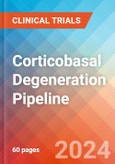Corticobasal Degeneration (CBD) Understanding
Corticobasal degeneration (CBD) is a rare condition that can cause gradually worsening problems with movement, speech, memory and swallowing. Corticobasal syndrome (CBS) is an atypical parkinsonian syndrome of great interest to movement disorder specialists and behavioral neurologists. Although originally considered a primary motor disorder, it is now also recognized as a cognitive disorder, usually presenting cognitive deficits before the onset of motor symptoms. The term CBS denotes the clinical phenotype and is associated with a heterogeneous spectrum of pathologies. Given that disease-modifying agents are targeting the pathologic process, new diagnostic methods and biomarkers are being developed to predict the underlying pathology. The heterogeneity of this syndrome in terms of clinical, radiological, neuropsychological and pathological aspects poses the main challenge for evaluation.Corticobasal Degeneration (CBD) is an X-linked recessive inherited disorder due to mutation in the CHM gene (OMIM 303390), which is placed on chromosome X at position q21.2. CHM messenger RNA (mRNA) is responsible for the creation of the Rab escort protein (REP)-1 which is ubiquitously expressed. This protein has 653 amino acids and is involved in intracellular migration of organelles and molecules. Especially, REP-1 manages the process aimed at attaching the unprenylated Rab proteins to the geranyl-geranyl transferase 2 enzyme.
'Corticobasal Degeneration (CBD) - Pipeline Insight, 2025' report outlays comprehensive insights of present scenario and growth prospects across the indication. A detailed picture of the Corticobasal Degeneration (CBD) pipeline landscape is provided which includes the disease overview and Corticobasal Degeneration (CBD) treatment guidelines. The assessment part of the report embraces, in depth Corticobasal Degeneration (CBD) commercial assessment and clinical assessment of the pipeline products under development. In the report, detailed description of the drug is given which includes mechanism of action of the drug, clinical studies, NDA approvals (if any), and product development activities comprising the technology, Corticobasal Degeneration (CBD) collaborations, licensing, mergers and acquisition, funding, designations and other product related details.
Report Highlights
The companies and academics are working to assess challenges and seek opportunities that could influence R&D Corticobasal Degeneration (CBD). The therapies under development are focused on novel approaches to treat/improve Corticobasal Degeneration (CBD).Corticobasal Degeneration (CBD) Emerging Drugs
APNmAb005: APRINOIA Therapeutics
APNmAb005 is a humanized anti-tau antibody specifically targeting human tau aggregates found in tau-related diseases including Alzheimer's Disease, Progressive Supranuclear Palsy, Corticobasal Degeneration, and other forms of Frontotemporal Lobar Degeneration. APNmAb005 preferentially binds tau aggregates accumulated at the neuronal synapses of AD patients, specialized sites critical for information transfer and release of transmissible abnormal tau species between brain cells. Clearance of tau aggregates at neuronal synapses by APNmAb005 is expected to significantly reduce tau pathology, synaptic injury, thereby slowing disease progression and restoring brain and cognitive health.Corticobasal Degeneration (CBD): Therapeutic Assessment
This segment of the report provides insights about the Corticobasal Degeneration (CBD) drugs segregated based on following parameters that define the scope of the report, such as:Major Players in Corticobasal Degeneration (CBD)
There are approx. 5+ key companies which are developing the therapies Corticobasal Degeneration (CBD). The companies which have their Corticobasal Degeneration (CBD) drug candidates in the most advanced stage, i.e preclinical include APRINOIA TherapeuticsPhases
The report covers around 5+ products under different phases of clinical development like
- Late stage products (Phase III)
- Mid-stage products (Phase II)
- Early-stage product (Phase I) along with the details of
- Pre-clinical and Discovery stage candidates
- Discontinued & Inactive candidates
Route of Administration
Corticobasal Degeneration (CBD) pipeline report provides the therapeutic assessment of the pipeline drugs by the Route of Administration. Products have been categorized under various ROAs such as- Oral
- Intravenous
- Subcutaneous
Molecule Type
Products have been categorized under various Molecule types such as
- Small molecule
- Cell Therapy
- Peptides
- Polymer
- Small molecule
- Gene therapy
Product Type
Drugs have been categorized under various product types like Mono, Combination and Mono/Combination.Corticobasal Degeneration (CBD): Pipeline Development Activities
The report provides insights into different therapeutic candidates in phase II, I, preclinical and discovery stage. It also analyses Corticobasal Degeneration (CBD) therapeutic drugs key players involved in developing key drugs.Pipeline Development Activities
The report covers the detailed information of collaborations, acquisition and merger, licensing along with a thorough therapeutic assessment of emerging Corticobasal Degeneration (CBD) drugs.Corticobasal Degeneration (CBD) Report Insights
- Corticobasal Degeneration (CBD) Analysis
- Therapeutic Assessment
- Unmet Needs
- Impact of Drugs
Corticobasal Degeneration (CBD) Report Assessment
- Pipeline Product Profiles
- Therapeutic Assessment
- Pipeline Assessment
- Inactive drugs assessment
- Unmet Needs
Key Questions
Current Treatment Scenario and Emerging Therapies:
- How many companies are developing Corticobasal Degeneration (CBD) drugs?
- How many Corticobasal Degeneration (CBD) drugs are developed by each company?
- How many emerging drugs are in mid-stage, and late-stage of development for the treatment of Corticobasal Degeneration (CBD)?
- What are the key collaborations (Industry-Industry, Industry-Academia), Mergers and acquisitions, licensing activities related to the Corticobasal Degeneration (CBD) therapeutics?
- What are the recent trends, drug types and novel technologies developed to overcome the limitation of existing therapies?
- What are the clinical studies going on for Corticobasal Degeneration (CBD) and their status?
- What are the key designations that have been granted to the emerging drugs?
Key Players
- Asahi Kasei
- Tapestry Pharmaceuticals
- AC Immune
Key Products
- Fasudil
- TPI 287
- PI2620
- APNmAb005
This product will be delivered within 2 business days.
Table of Contents
Companies Mentioned (Partial List)
A selection of companies mentioned in this report includes, but is not limited to:
- Asahi Kasei
- Tapestry Pharmaceuticals
- AC Immune








